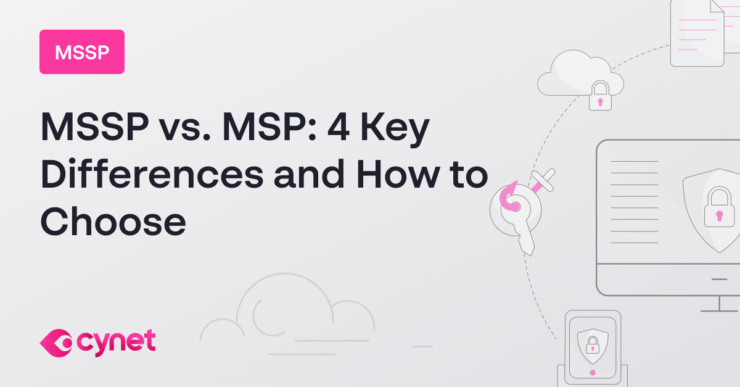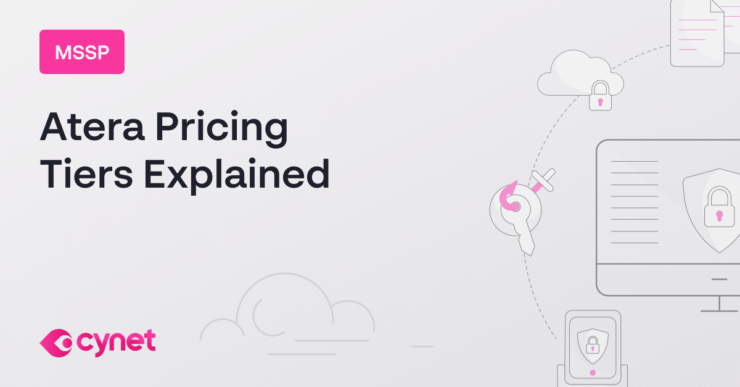August 28, 2023
Last Updated:
January 17, 2025
What is an MSSP?
A managed security service provider (MSSP) is a third-party organization that oversees and administers an enterprise’s cybersecurity requirements. They offer a wide array of services, which may include managing firewalls, intrusion detection, virtual private networks (VPNs), conducting vulnerability scanning, and ensuring regulatory compliance.
The primary role of an MSSP is to prevent security incidents from happening in the first place. They are focused on maintaining a solid security infrastructure that can ward off potential threats. By outsourcing their security needs to an MSSP, companies can focus on their core business functions while leaving their cybersecurity in expert hands.
However, it’s important to note that while MSSPs are instrumental in establishing a robust security framework, their capabilities are often limited when it comes to detecting and responding to complex threats. In the face of sophisticated cyber-attacks, the preventative measures enforced by MSSPs might not be enough. This is where MDR comes in.
What is MDR?
Managed detection and response (MDR) is a service that provides threat detection, incident response, and continuous monitoring for businesses. Unlike traditional security measures that only focus on prevention, MDR goes a step further by identifying ongoing threats and responding to them swiftly.
MDR providers leverage advanced technologies such as endpoint protection platforms (EPPs), endpoint detection and response (EDR), and extended detection and response (XDR) to detect anomalous activities and potential threats. Once a threat is identified, the MDR provider doesn’t just alert the client but also takes necessary actions to mitigate the risk.
The adoption of MDR is particularly beneficial for businesses that lack the in-house resources or expertise to deal with advanced threats. By having a dedicated team of experts on their side, businesses can ensure a rapid and effective response to security incidents, minimizing the potential damage.
Read our another article to compare MSSP vs. MSP.
MSSP vs MDR: 4 Key Differences
1. Differences in Services
MSSPs typically offer a broad range of security solutions, from firewall management and intrusion prevention to vulnerability scanning and regulatory compliance. They are primarily focused on maintaining a secure environment through preventative measures.
MDR providers specialize in detecting and responding to threats. They employ advanced technologies to continuously monitor the network, detect anomalies, and respond to incidents. MDR services are more in-depth and specialized compared to the general security services offered by MSSPs.
Learn more in our detailed guide to managed service provider examples (coming soon)
2. Differences in Operating Models
MSSPs usually operate on a shared responsibility model, where the client retains some control over their security operations. The MSSP provides the necessary tools and support, but the client is often responsible for managing and interpreting the outputs.
MDR operates on a turnkey model. The MDR provider not only detects threats but also responds to them. The client is kept in the loop, but the bulk of the responsibility rests with the MDR provider. This model can be particularly beneficial for businesses that lack the necessary resources or expertise to handle advanced threats.
3. Outcomes: Proactive vs Reactive Approach
Another significant difference between MSSP and MDR lies in their approach to security. MSSPs typically adopt a preventive, or reactive, approach. They put measures in place to prevent security incidents, but their capacity to respond to an active threat is often limited.
On the flip side, MDR providers adopt a proactive approach. They continuously monitor the network for suspicious activities, detect threats in real-time, and respond swiftly to mitigate the impact. This approach ensures that businesses can promptly address security incidents, minimizing their potential damage.
4. Pricing and Cost Implications
The cost of MSSP and MDR services can vary widely, depending on the scope and complexity of the services. Generally, MSSPs charge based on the number of devices or users, making their pricing model relatively straightforward.
MDR providers, on the other hand, usually charge based on the level of service. This could include factors such as the number of endpoints monitored, the complexity of the network, and the frequency and type of reports required.
Making the Right Choice: MSSP or MDR?
Here are the key factors you should consider when deciding between an MSSP and MDR service.
Organization Size
The size of your organization plays a crucial role in your choice between MSSP and MDR. An MSSP is often the preferred choice for large corporations with complex IT infrastructures. These organizations require a wide range of security services, from vulnerability management to intrusion detection and prevention, which MSSPs can provide. However, many MSSPs are specifically focused on serving small to medium-sized enterprise clients.
On the other hand, MDR services are usually more suitable for small to medium-sized businesses. These organizations often lack the resources to manage a wide array of security services, and MDR providers offer a more streamlined and focused approach to security. They focus on detecting and responding to threats in real-time, which is particularly important for smaller organizations that may be more vulnerable to cyber-attacks.
Industry Regulations
Industry regulations also play a significant role in your choice between MSSP and MDR. Some industries, such as healthcare and finance, are subject to stringent regulations that require organizations to have specific security measures in place. In such cases, an MSSP may be the better choice, as they offer a broad spectrum of security services that can help organizations comply with these regulations.
However, if your industry regulations are not as strict, or if they focus more on the detection and response to threats, an MDR service may be more appropriate. MDR providers specialize in monitoring your systems for threats and responding to them promptly, which can help you meet regulatory requirements related to threat detection and response.
Internal IT Resources
Your internal IT resources are another important factor to consider when choosing between MSSP and MDR. If your organization has a large IT department with the capacity to manage and monitor a wide range of security services, an MSSP may be a good fit. MSSPs offer a variety of security services, but they often require organizations to have some level of internal IT resources to manage these services effectively. Some MSSPs take on more responsibilities, so make sure this is clarified up front.
Conversely, if your organization has limited IT resources, an MDR service may be the better choice. MDR providers take a more hands-on approach to security, providing not only detection and response services but also guidance on how to manage and mitigate threats. This can be particularly beneficial for organizations with limited IT resources.
Risk Profile
Lastly, your organization’s risk profile is a crucial factor in your choice between MSSP and MDR. If your organization is at high risk of cyber-attacks, either because of the nature of your business or because of specific threats in your industry, an MDR service may be the best choice. MDR providers specialize in detecting and responding to threats in real-time, which can be crucial for high-risk organizations.
However, if your organization’s risk profile is lower, or if you need to comply with specific security regulations, an MSSP may be more appropriate. MSSPs offer a broad range of security services and can help organizations meet their regulatory requirements, making them a good choice for lower-risk organizations or those subject to specific security regulations.
In conclusion, the choice between MSSP and MDR depends on your organization’s unique needs and circumstances. By considering your organization’s size, industry regulations, internal IT resources, and risk profile, you can make an informed decision that best suits your cybersecurity needs.
Learn more in our detailed guide to best managed security service providers (coming soon)
In my experience, here are tips that can help you better adapt to the topic of MSSP (Managed Security Service Provider) and MDR (Managed Detection and Response):
- Clarify Scope of Responsibility: Ensure clear delineation of roles between your internal IT team and the MSSP to avoid response delays and misunderstandings.
- Leverage MDR for Advanced Threats: If your organization has faced advanced threats, consider MDR services for deeper visibility into attacker tactics and post-compromise behavior.
- Threat Intelligence Integration: Prioritize providers that integrate real-time threat intelligence feeds into their systems to enhance detection capabilities and identify evolving threats.
- Regulatory Compliance: If compliance is a priority, choose an MSSP that offers compliance mapping and reporting services.
- Test Response Times: Conduct regular security assessments to evaluate the response time of your MSSP or MDR provider and ensure they can handle real-world incidents effectively.
These tips provide a solid foundation for businesses to navigate the complex landscape of MSSP and MDR services and make informed decisions that align with their specific needs and goals.
Eyal Gruner is the Co-Founder and Board Director at Cynet. He served as the company’s CEO for nine years, guiding its growth from the very beginning. He is also Co-Founder and former CEO of BugSec, Israel’s leading cyber consultancy, and Versafe, acquired by F5 Networks. Gruner began his career at age 15 by hacking into his bank’s ATM to show the weakness of their security and has been recognized in Google’s security Hall of Fame.
Cynet for MSSPs
As an MSSP, your customers rely on you to keep them safe from the myriad risks they face each day. The process of knowing which tools are the optimal fit for the job can be complex. Cynet offers complete breach protection services, providing a single multi-tenant platform that simplifies the task of delivering holistic security across your entire customer base.
Cynet is the ultimate force multiplier, enabling MSSPs to provide their customers with unmatched security, without the need for multiple products and resources. It provides maximum threat visibility and responsiveness, enhancing security team productivity and increasing ROI. Only Cynet gives the power of proactive 24/7 MDR services, continuously monitoring all alerts across your customers’ environments to keep them protected at all times, even from the most complex threats.
Key benefits of Cynet for MSSPs include:
- Designed for MSSPs: Cynet offers a scalable multi-tenant platform with true client separation down to the data, a centralized dashboard for alerts, forensics, and remediation, and supports both full-management and end-client management.
- Enables a highly differentiated service: Cynet is a complete XDR platform including NGAV, EPP, EDR, UBA Rules, Network Detection Rules, and Deception. It offers fully automated threat response workflows and proactive 24/7 MDR services for all clients.
- Reducing management and delivery costs: Cynet allows extremely rapid deployment, replacing multiple solution providers with a single pre-integrated offering and a lightweight agent that minimizes maintenance requirements.
- Tailored for your success: Cynet’s partner pricing structure enables higher margins to partners. It offers marketing, sales, and technical support across deployment, management, and maintenance. Partners also get access to the Cynet Academy, which includes sales and technical training, sales videos, and certification.
With Cynet, your customers can enjoy proactive protection from dynamic and advanced cyber threats. Become a partner today!



